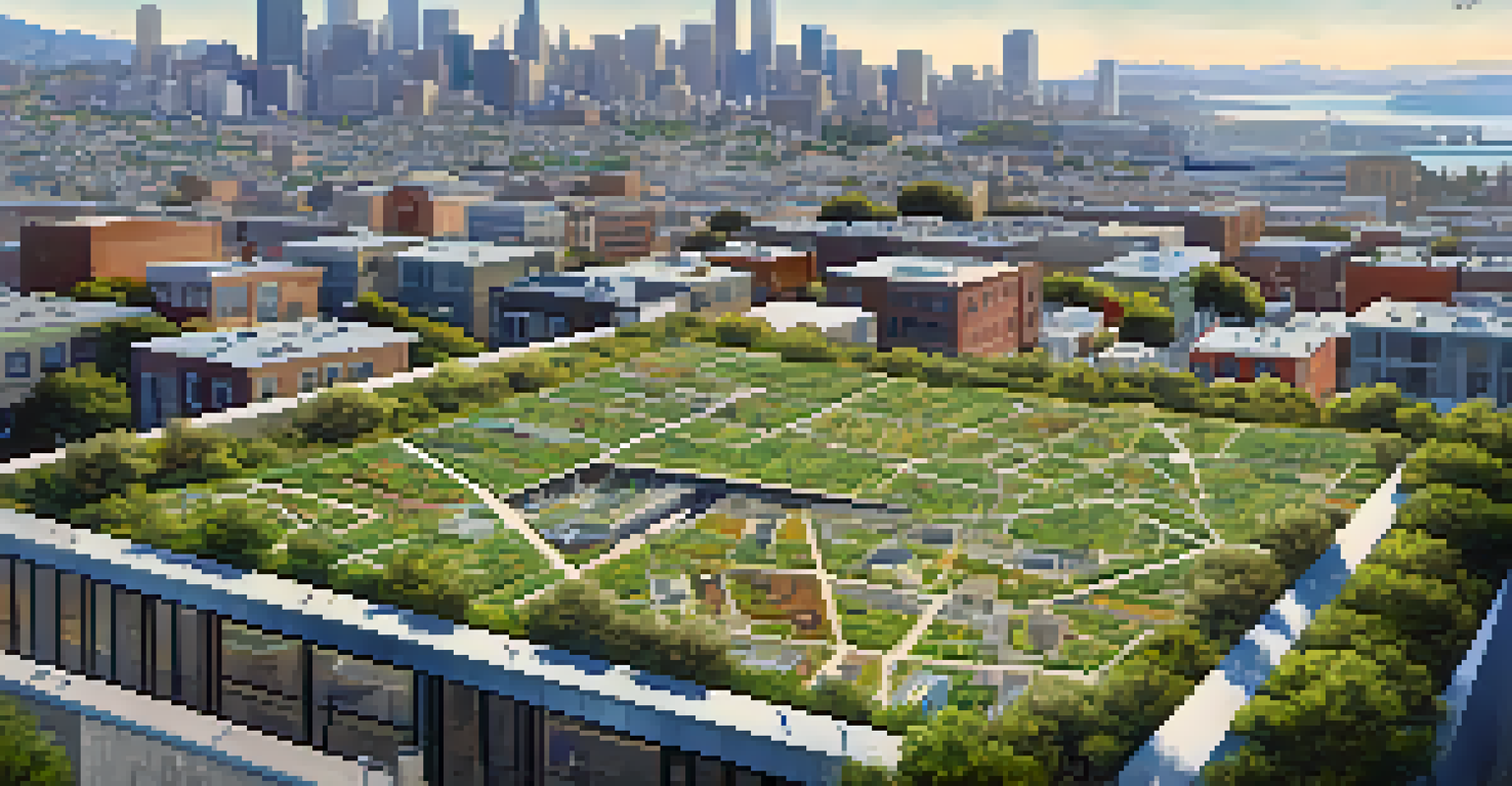San Francisco's Climate Resilience Strategies for Coastal Areas

Understanding the Coastal Vulnerabilities of San Francisco
San Francisco's unique geography places it at the forefront of climate vulnerability, particularly along its iconic coastlines. Rising sea levels, increased flooding, and erosion threaten not only the natural beauty of the area but also the communities that call it home. With over 800,000 residents living near the coast, understanding these challenges is crucial for effective planning and response.
We won’t be able to prevent climate change, but we can prevent its worst effects.
The city experiences a range of climate-related issues, from heavy rainfall leading to urban flooding to the risk of storm surges during winter months. These challenges highlight the urgent need for comprehensive strategies that address both immediate impacts and long-term sustainability. As the effects of climate change become increasingly evident, San Francisco's approach serves as a model for other coastal cities facing similar threats.
To combat these vulnerabilities, San Francisco has prioritized climate resilience as a key aspect of urban planning. By identifying at-risk areas and leveraging scientific research, city planners aim to create adaptive solutions that protect both the environment and local communities.
Key Climate Resilience Strategies in Action
San Francisco employs a variety of strategies to enhance its climate resilience, focusing on both infrastructure and community engagement. One notable initiative is the development of the 'San Francisco Sea Level Rise Action Plan,' which outlines specific actions to mitigate flooding and protect vulnerable neighborhoods. This plan emphasizes collaboration with various stakeholders, including residents, businesses, and environmental groups.

Another significant strategy involves the improvement of natural barriers, such as wetlands and marshes, which act as buffers against storm surges. By restoring these ecosystems, the city not only protects infrastructure but also enhances biodiversity, making the area more resilient overall. These green solutions are often more sustainable and cost-effective compared to traditional engineering approaches.
San Francisco's Climate Vulnerabilities
The city's unique geography makes it highly vulnerable to rising sea levels, flooding, and erosion.
Community involvement plays a vital role in these strategies, with local residents encouraged to participate in planning processes. This collaboration fosters a sense of ownership and ensures that solutions are tailored to the specific needs and concerns of different neighborhoods, ultimately leading to stronger collective action.
The Role of Technology in Climate Resilience
Technology is a powerful ally in San Francisco's efforts to bolster climate resilience. The city utilizes advanced data analytics and modeling to predict flooding patterns and assess risks associated with climate change. These insights inform decision-making processes and help prioritize areas that require urgent attention.
The future will be different if we make the present different.
Innovative solutions, such as smart drainage systems and real-time monitoring of water levels, are being implemented to enhance response capabilities during extreme weather events. By leveraging technology, the city can respond more quickly and effectively to emerging threats, ultimately minimizing damage and ensuring public safety.
Moreover, the integration of technology into community engagement platforms allows residents to access critical information and participate in climate resilience initiatives. This transparency fosters trust and empowers citizens to take an active role in shaping their environment, reinforcing the city's commitment to collaborative problem-solving.
Investing in Green Infrastructure Solutions
San Francisco recognizes the importance of green infrastructure in its climate resilience strategies. Initiatives like green roofs, permeable pavements, and urban forests are designed to manage stormwater runoff while enhancing the urban landscape. These solutions not only help mitigate flooding but also improve air quality and provide recreational spaces for residents.
The city's commitment to developing green infrastructure is evident in projects like the 'Urban Forest Plan,' which aims to increase tree canopy coverage across the city. Trees play a critical role in capturing rainwater, reducing heat islands, and providing habitat for wildlife. By investing in these natural assets, San Francisco fosters a sustainable urban ecosystem that benefits both people and nature.
Innovative Climate Resilience Strategies
San Francisco employs diverse strategies, including green infrastructure and community engagement, to enhance its resilience against climate change.
Furthermore, these green initiatives often lead to economic benefits, such as increased property values and reduced energy costs. By integrating nature into urban planning, San Francisco showcases how environmental stewardship can align with economic growth, setting a precedent for other cities looking to enhance their resilience.
Community Engagement and Education Initiatives
Community engagement is a cornerstone of San Francisco's climate resilience efforts, ensuring that local voices are heard in decision-making processes. The city organizes regular workshops, town hall meetings, and educational campaigns to raise awareness about climate change impacts and resilience strategies. These initiatives create opportunities for dialogue, enabling residents to express their concerns and contribute ideas.
Educational programs in schools also play a crucial role in fostering a culture of sustainability among younger generations. By integrating climate education into curricula, students learn about the importance of environmental stewardship and the steps they can take to contribute to resilience. This not only empowers youth but also encourages families to adopt sustainable practices at home.
Ultimately, community engagement strengthens social ties and enhances collective action. When residents feel informed and involved, they are more likely to participate in local initiatives and support climate resilience efforts, creating a sense of shared responsibility for the future of their communities.
Partnerships with Local Organizations and Agencies
San Francisco's climate resilience strategies are bolstered by strong partnerships with local organizations and agencies. Collaborations with environmental nonprofits, academic institutions, and government agencies allow the city to leverage diverse expertise and resources. These partnerships play a vital role in enhancing the effectiveness of resilience initiatives and ensuring that a wide range of perspectives are considered.
For example, organizations like the San Francisco Bay Conservation and Development Commission work alongside the city to implement policies that address sea level rise and habitat restoration. These collaborative efforts help align regional goals with local actions, creating a more cohesive approach to climate resilience across the Bay Area.
Collaboration Drives Effective Solutions
Strong partnerships with local organizations and agencies bolster the city's climate initiatives, ensuring a comprehensive approach to resilience.
Additionally, engaging with local businesses fosters innovative solutions and economic investment in climate resilience. By encouraging private sector involvement, the city can tap into new technologies and sustainable practices that contribute to its overall resilience strategy, creating a more robust and adaptable community.
Looking Ahead: Future Challenges and Opportunities
As San Francisco continues to navigate the challenges posed by climate change, the city remains committed to evolving its resilience strategies. Future challenges include increasing urbanization, continued sea level rise, and the need for sustainable economic growth. Addressing these issues requires innovative thinking and the flexibility to adapt strategies as conditions change.
Opportunities for enhancing resilience lie in ongoing collaboration with stakeholders across multiple sectors. By fostering partnerships and encouraging community participation, San Francisco can create a resilient urban landscape that meets the needs of its residents while protecting the environment. The city's proactive approach serves as an example for others facing similar challenges.

Ultimately, the journey towards climate resilience is ongoing, and San Francisco is well-positioned to lead the way. With a focus on sustainability, community engagement, and innovative solutions, the city is not just preparing for the future—it’s actively shaping it.